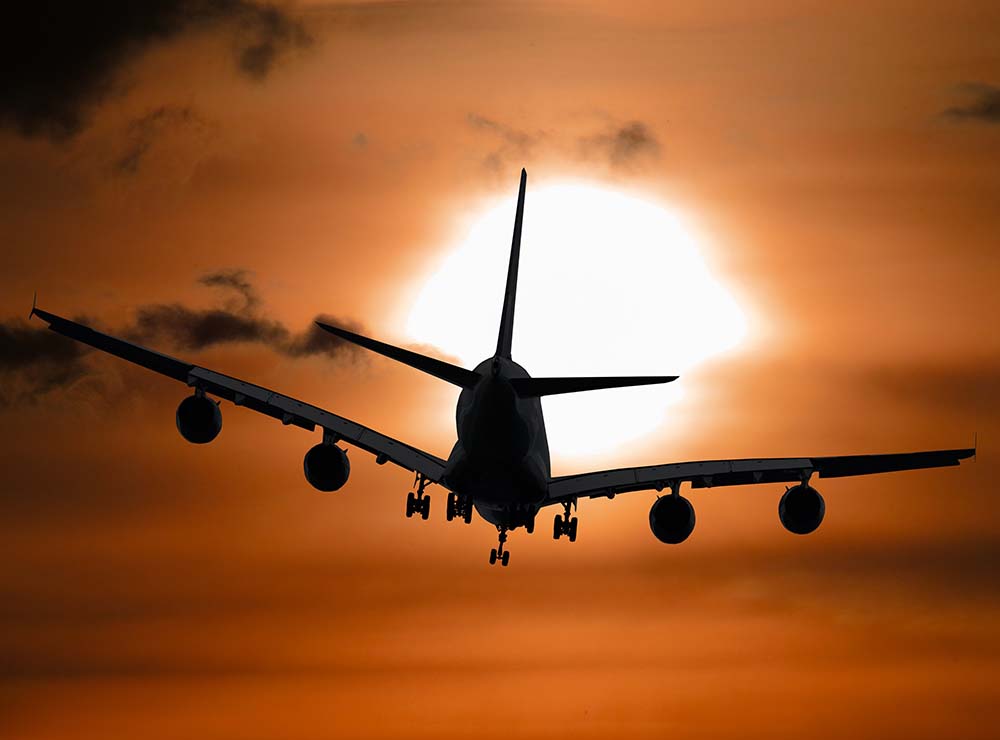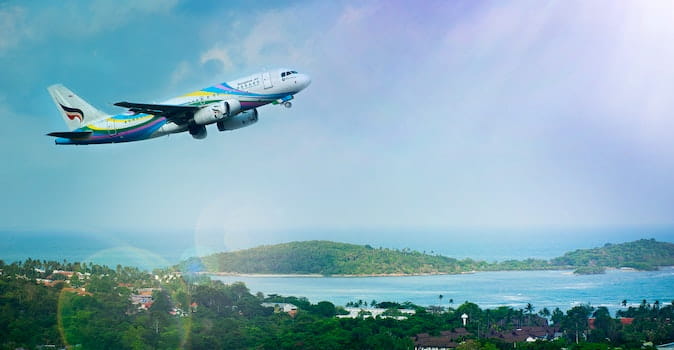Travel More Sustainably in 2023
As Seen In
Learn How to Travel More Sustainably by Carbon Offsetting Your Flights
With so much emphasis on reducing the carbon footprint, being conscientious about how air travel will affect the environment matters. Whether traveling domestically or internationally, carbon offsetting for flights helps combat the impact of flight travel. Find out what carbon offsetting is, how it works, and how travelers can participate in making a difference.
There's a World of Trips Out There. Bring Us With You. Let's Go.
Travel can represent financial risk. No matter your destination, there’s always a chance you could face an unanticipated cancellation, interruption, mishap, or emergency.
WorldTrips offers travel insurance and travel assistance services to guide you through the unexpected and help ease your stress. We enable travelers to explore the world with confidence.
- A partner when you need it. Contact us anytime and from anywhere. Our multilingual customer support team is on call 24/7 to answer your questions if an emergency arises.
- A plan to fit you. Choose from several different types of travel insurance with varying coverage levels and optional upgrades to create personalized coverage for your trip.
- Proof of coverage. Proof of coverage will be delivered to you immediately upon purchase. Easily access your insurance card and visa letter to prove you have coverage throughout your entire trip.
What You Need to Know About Carbon Offsetting Flights
When you’re sitting at the airport or on an airplane, do you ever wonder how much a single flight affects the environment? What about a flight that involves a connection? How about all your flights that year? Or in your lifetime?
Though convenient, air travel isn’t the best for the environment. The real impact of air travel on the environment means many individuals and companies are working on ways to curb emissions and support organizations that work to combat climate change.
So, what is carbon offsetting flights, and how does that tie in with this? Carbon offsetting travel is just one way to invest in lessening your carbon footprint when you fly. To carbon offset flights, the idea is that every time you fly, you donate a certain amount of money to a fund or organization that supports environmental sustainability and carbon offsetting.
Getting involved is easy since this has become a major initiative among airlines. Anyone can purchase a carbon offset, but carbon neutral flights and partners have a vested interest in carbon emissions. In essence, offsets are a huge part of a carbon emission reduction strategy that minimizes the impact through air travel.
There are many different airline carbon offset programs already in place by airlines like Delta, Alaska Airlines, JetBlue, United, AirCanada, Austrian, and more. For instance, United offers a carbon footprint flight calculator and allows its passengers to purchase carbon credits. While it may not seem like you’re making a big difference, you’re helping to fund programs that rely on everyone’s support.
On this page, we’ll be providing guidance and resources regarding carbon offsetting. Here are the topics that we’ll cover:
- An Overview of Carbon Offset Travel
- Carbon Footprint of Flying vs Driving
- CO2 Emissions Per Flight Per Person
- Does Carbon Offsetting Flights Work?
- How to Buy Carbon Offsets

An Overview of Carbon Offset Travel
When and where did carbon offsetting originate? According to Impactful Ninja, carbon offsetting started around 1989 in Guatemala. There were three phases of development where corporations all committed to policies crafted to address carbon neutrality.
The travel industry got involved as it began implementing its own sustainability initiatives. Industry leaders realized that carbon offsets are one way they can continue to provide travel services while countering the impact of these services on the environment.
Carbon offset travel is important because air travel emissions directly impact the environment. Carbon offsetting helps in providing resources to projects like renewable and clean energy. There are many different types of offset projects.
For example, one of the most common project types involves forestry. Organizations will plant new trees (and sometimes advocate for the end to deforestation) because trees are vital for removing carbon dioxide from the atmosphere. Renewable technology and energy efficiency are other common projects for carbon offsetting.
Carbon Footprint of Flying vs Driving
Some travelers might be deciding between flying and driving as their main transportation options. The carbon footprint of flying vs driving can be calculated in many ways.
According to Treehugger, automobiles account for several types of pollution:
- Carbon monoxide
- Hydrocarbons
- Nitrogen oxides
- Particulate matter
In general, Treehugger states that “passenger cars currently account for the largest portion of transportation-related GHG [greenhouse gas] emissions.” However, air travel is one of the fastest-growing polluters.
Like cars, airplanes emit multiple types of emissions (like carbon dioxide), but they also leave contrail clouds—which are a lot worse than regular carbon dioxide production.
So, which is better? Well… it’s complicated.
The U.K. Department for Business, Energy, and Industrial Strategy (BEIS) reports that domestic flights emit 22% less carbon dioxide per person and per mile than a diesel car (with only one passenger). However, if you factor in contrail clouds, domestic flights can generate 49% more overall emissions than cars.
You’ll also want to consider the distance of travel. Long-haul flights tend to be more efficient than shorter trips since most emissions are released during takeoff and landing.
There’s no right or wrong answer to which way is best, but it’s advised to take additional steps to make your travel more sustainable, like:

Co2 Emissions Per Flight Per Person
With tourism creating 8% of the carbon emissions in the world, it’s important to understand the average emissions per flight, especially if you’re committed to sustainable travel.
What Is the Average Emissions Per Flight Meaning?
Average carbon emission estimates consider the flight’s starting point and destination, the type of aircraft, and the number of seats in each seating class. Shorter routes and fuel-efficient aircrafts typically produce lower carbon emissions per flight.
There are a few carbon offset calculators available online to help you determine your CO2 emissions per flight per person. A CO2 emissions per flight calculator like Sustainable Travel International’s will calculate one passenger’s carbon emissions per kilometer, which is about 0.14 to 0.55 kilograms based on cabin class and the distance of the flight.
Conservation International’s calculator will demonstrate the math as it calculates, and Atmostfair’s calculator will total the entire average emissions per flight based on the cabin, route, and aircraft type.
There are different types of emissions based on the plane. For instance, you may be asking yourself “How much CO2 does a 747 produce?” According to Carbon Independent, it’s 90kg of CO2 per passenger per hour. Now, calculate the CO2 emissions per flight based on the number of passengers and you realize that’s a lot of carbon dioxide production.
These calculators can be helpful in gaining a better perspective on how your travel impacts the environment. It can also guide you in determining how much to donate to carbon offset programs.

Does Carbon Offsetting Flights Work?
Many people ask the question, “Does carbon offsetting flights work?” Some people may be skeptical of how much of a difference they are really making.
Carbon offset projects are designed to help the environment and curb the impact of your travel. Individuals or companies can donate and purchase carbon offsets from organizations that are working to combat the impact of travel on the environment.
To get started, use a travel carbon footprint calculator to determine the exact carbon emission from the flight you’ll be taking.
You can either donate directly within your flight purchase path or choose an organization to donate to directly. Many organizations working to combat climate change and remove carbon are underfunded and rely on the donations of people to do their work.
For example, British Airways implemented UK-centered carbon offset flights in January 2020. At that time, the company began offsetting carbon emissions on all flights within the UK, making all domestic flights via British Airways carbon neutral.
British Airways passengers can direct their carbon offsets to one of the following carbon offset programs:
- Forest protection in Cardamom, Cambodia
- Sustainable cooking stoves for families in Darfur, Sudan
- Forest protection in Cordillera Azul, Peru
Other airlines and some programs within the U.S. offer similar benefits. Carbon offset programs supported may include forestry, clean and efficient energy, community-based carbon projects, the purchase of efficient cookstoves, renewable energy, environmental education, water filter projects, geothermal energy projects, landfill gas capture, abandoned coal mine methane capture, waste management, and more.
The key is to check with any airlines you are interested in to inquire whether they have carbon-offsetting flights or any other type of program for reducing carbon emissions.
How to Buy Carbon Offsets
There are different ways to purchase carbon offsets, whether it’s through companies that specialize in carbon offsetting or within the direct purchase path of a flight or trip. Here is a list of airlines currently offering programs that allow you to donate directly while making a purchase:
- British Airways
- Qantas
- Virgin Australia
- Delta
- Air New Zealand
- United
- JetBlue
- Scandinavian Airlines
While these airlines are making it very easy for their passengers, there are additional companies that help purchase carbon offsets. If you’re curious about how to buy carbon offsets directly from a carbon offsetting organization, refer to the best carbon offsets for air travel programs listed below:
- Sustainable Travel International
- Atmosfair
- GoClimate
- Terrapass
- MyClimate
- Cool Effect
- Carbonfund
- Climate Care
- Clear
Individuals aren’t the only ones purchasing carbon offsets for their carbon emitting activities. There are major corporations buying carbon offsets as well. These companies are doing this to help develop carbon reduction strategies that will eliminate internal emissions and fund reduction projects outside of their value chain.
These 12 companies are using carbon offsets positively to reach their sustainability goals:
- Alphabet
- Cemex
- Delta
- Disney
- General Motors
- Honeywell
- JetBlue
- Microsoft
- PG&E
- Salesforce
- Shell
- Unilever
While the lens on carbon offset programs is still developing, sustainable options that help lessen the carbon footprint of global tourism must come to the forefront—especially for passengers who frequently travel by air.
Let's Prepare For The Unexpected With Travel Insurance
Quotes are free. Start yours now.
Select which option best describes you to start your quote.
KHE2FFFYH6SP-971744701-431
WorldTrips is a service company and a member of the Tokio Marine HCC group of companies.
WorldTrips’ Atlas Travel Series and StudentSecure international travel medical insurance products are underwritten by Lloyd's. WorldTrips has authority to enter into contracts of insurance on behalf of the Lloyd's underwriting members of Lloyd's Syndicate 4141, which is managed by HCC Underwriting Agency, Ltd.
WorldTrips' Atlas Journey, Atlas Cruiser, and Atlas On-The-Go trip protection insurance products are underwritten by Tokio Marine HCC's U.S. Specialty Insurance Company (USSIC). USSIC is a Texas-domiciled insurance company operating on an admitted basis throughout the United States. Coverage is available to U.S. residents of the U.S. states and District of Columbia only. This plan provides insurance coverage that only applies during the covered trip. You may have coverage from other sources that provides you with similar benefits but may be subject to different restrictions depending upon your other coverages. You may wish to compare the terms of this policy with your existing life, health, home, and automobile insurance policies. Coverage may not be available in all states.
In the State of California, operating as WorldTrips Insurance Services. California Non- Resident Producer License Number: 0G39705



